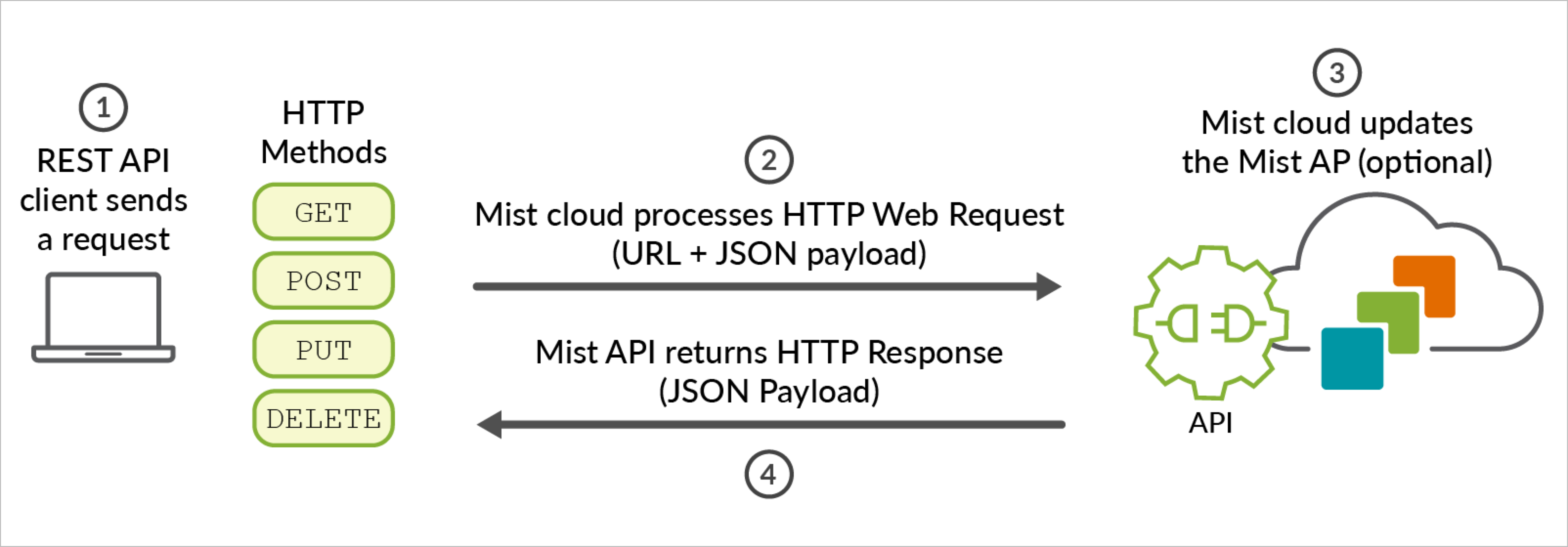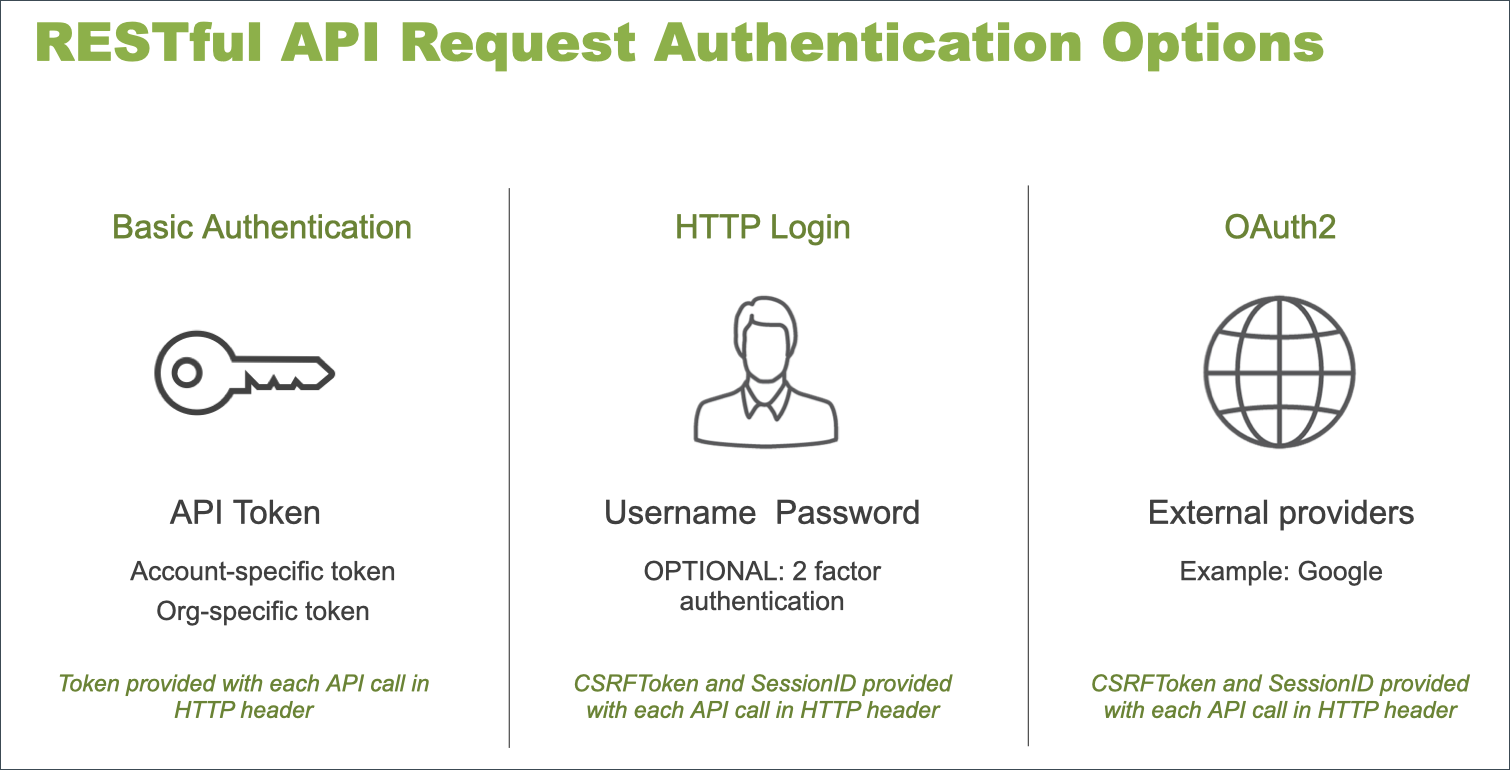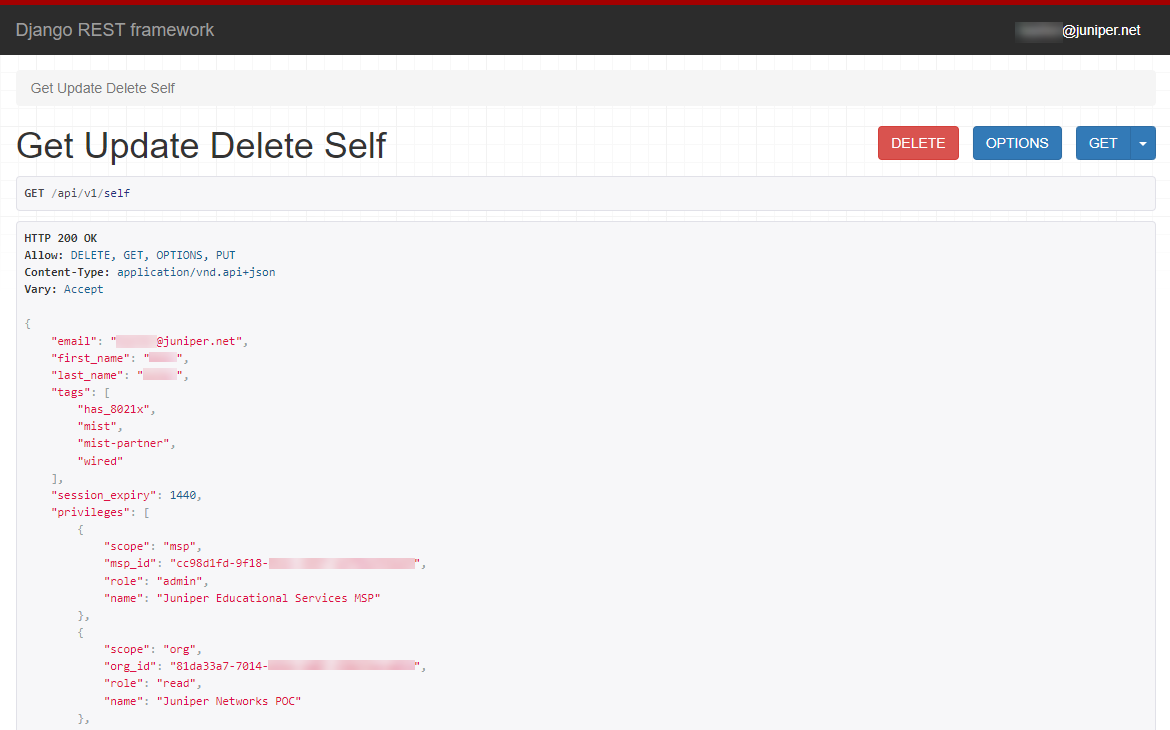RESTful API Overview
Get familiar with Representational State Transfer (REST) and understand how you can use RESTful APIs with Juniper Mist™.
The 100% API architecture of Juniper Mist backs every visible feature in the Juniper Mist portal. Anything that you can do in the portal, you can automate at scale by using the API. Representational State Transfer (REST) is a stateless client/server architecture with a uniform interface. Since machines have no use for a user interface, APIs allow for a defined and faster way for machines to communicate with each other.
REST APIs enable you to create your own way of interacting with systems and applications. You can even create custom features. Other common use cases for REST APIs include communication and data exchange between applications, data exchange between applications and servers, communication between microservices within an application, and more. REST is stateless, which makes it ideal for cloud-based services.
The Juniper Mist API is available to any customer with a Juniper Mist account.
Also see the Mist API Reference. This contains additional documentation for developers, as well as the ability to test API calls.
Juniper Mist API Architecture
Juniper Mist uses REST APIs, which use HTTP methods (GET, POST, PUT, and DELETE) to transfer data in JavaScript Object Notation (JSON) format.

RESTful API Requests
Using RESTful APIs follows a similar practice to the CRUD (CREATE, READ, UPDATE, DELETE) methodology used in development. These are the four basic actions or functions used when working with data.
| CRUD | HTTP/REST |
|---|---|
| Create | POST |
| Read | GET |
| Update | PUT |
| Delete | DELETE |
API Endpoint URL Format
The API endpoint URL has two parts:
-
API Host ( or Endpoint)—The endpoint for the global region that your Juniper Mist organization is associated with. These endpoints are listed in API Endpoints and Global Regions.
-
Function—Everything after the API endpoint represents the function that the API will call.
Example
https://{api-host}/api/v1/sites/{site_id}/stats/devices/{device_id}.
https://api.mist.com/api/v1/sites/13b0ee00-121a-456e-84e0-ead3008bc2f2/stats/devices/00000000-0000-0000-1000-d420b08532eb
When reusing code blocks, replace placeholder values with actual values, such as your API token, organization ID, site ID, AP name, and so on.
Everything after {api-host} is the function. The call goes to the global cloud and requests the statistics for the specified device at the specified site.
The next section takes a deeper look at the structure that makes up an API call.
API Call Structure
The following image is an example of an API call and the different components that make it up.

|
API Call Component |
Description |
|---|---|
|
HTTP Method |
|
|
Host (or API Endpoint) |
Determines the Mist Cloud to use (Global 01, EMEA 01, etc). The endpoint for the global region that your Juniper Mist organization is associated with. See API Endpoints and Global Regions. |
|
Version |
The API version to use (currently, all APIs use v1). |
|
Scope |
Indicates the level that the request is being done at. Examples include msp, org, site, self, register, installer, const, and so on. |
|
Scope ID |
Identifies the scope to use. |
|
Object |
The type of object to use (Device, WLAN, and so on). |
|
Object ID |
Identifies the object to request. |
To perform any of the above REST commands (POST, GET, PUT, DELETE) on the REST API, you need to fulfill a few requirements in each request, such as:
-
Authentication:
-
You can use an API token, Juniper Mist login credentials (this authentication type to be deprecated September 2026), or an external OAuth2 provider to indicate who you are and what you have access to during the authentication process.
-
For more detail on the various authentication methods, see Authentication.
Note:If you are already logged in on manage.mist.com, you can simply open a new browser tab and go to https://api.mist.com/api/v1/self/apitokens and click the POST button. This will automatically create a new api user token.
See Create API Tokens for more information about tokens.
-
-
HTTP Header: This header specifies the content and the authorization type, as follows:
-
For Juniper Mist, the content type is always application/json.
-
The authorization can be a token or a cookie (including CSRF token and session ID).
-
-
The endpoint for the global region that your Juniper Mist organization is associated with. See API Endpoints and Global Regions.
The following table provides examples for the different parts that make up a RESTful API request.
|
CRUD Operation |
HTTP Header Authentication |
Endpoint URL |
Payload (JSON) |
|---|---|---|---|
|
GET |
API Token |
https://api.mist.com/api/v1/sites/:site_id/wlans |
|
|
DELETE |
CSRF Token, Session ID |
https://api.mist.com/api/v1/sites/:site_id/wlans/:wlan_id |
|
|
POST |
CSRF Token, Session ID |
https://api.mist.com/api/v1/orgs/:org_id/inventory |
{["<claim_code>"]} |
|
PUT |
API Token |
https://api.mist.com/api/v1/sites/:site_id/wlans/:wlan_id |
{"ssid" : "New Name"} |
JSON Payload
Different functions require different elements in the JSON payload. You can view the required details in the API documentation.
The following is a sample API call and the response (JSON payload).
API call:
POST
/api/v1/orgs/{org_id}/rftemplatesResponse (JSON Payload):
{
"name": "new-rf-template",
"org_id": "a97c1b22-a4e9-411e-9bfd-d8695a0f9e61",
"band_5": {
"allow_rrm_disable": false,
"ant_gain": 0,
"channels": [],
"disabled": false,
"power_max": 17,
"power_min": 8
},
"band_24": {
"allow_rrm_disable": false,
"ant_gain": 0,
"channels": [],
"disabled": false,
"power_max": 17,
"power_min": 8
},
"country_code": "CA"
}API Rate Limiting
Juniper Mist limits API calls to 5,000 per hour. If you need to make more than 5,000 calls per hour, Create a Support Ticket.
For large deployments, it is recommended that you make API calls at the organization-level to avoid reaching the API call limit quickly.
To prevent brute-force attacks, the login API (/api/v1/login) is rate-limited after three login failures.
API Authentication Options
The Juniper Mist API allows three options for requesting authentication:

-
Basic Authentication—Token
-
Secure it like a password.
-
For instructions about creating an API token, see Create API Tokens.
Attention: To enhance security and align with industry best practices, Mist will deprecate Basic Authentication for all use cases—including admin logins and scripts—effective September 2026. Before September 2026, all integrations must transition to token-based authentication to ensure uninterrupted access and support. See Create API Tokens. -
-
HTTP Login— User name and Password
-
Is like a dashboard login.
-
Can be two-factor authentication.
-
-
OAuth2
-
Account must be linked to an OAuth provider.
-
Requires browser access.
-
For more information about Authentication, see the Mist API Reference.
A Simple API Example
The Django API interface is a web-based interface where you can perform CRUD operations within the API. See Use the Django Web Interface to Make API Changes.
Using the Django API interface, you can make your first API call. After logging in to Mist,
open a new window using the same browser and enter the URL
https://api.mist.com/api/v1/self. This is the URL for the the
Global 01 cloud. If you are using another cloud, this URL will be different.
This is equivalent to making this API call GET /api/v1/self.
The result, shown above, displays the privileges assigned to you for the organizations and sites you are associated with.
